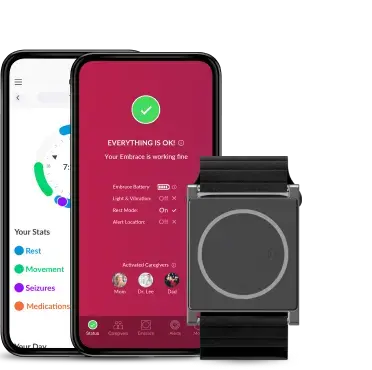EmbracePlus on Mars by the 2030s
Photo credit: NASA
The exploration of Mars has been a goal of national space programs since the earliest days of modern rocketry.
There are several strategic, practical, and scientific reasons for humans to explore Mars. Among them, we know that Mars is the most accessible place in the solar system. Additionally, exploring Mars provides the opportunity to possibly answer origin and evolution of life questions and could someday be a destination for the survival of humankind.
The path to Mars
NASA’s space exploration goal is to conduct a crewed mission to the surface of Mars by the 2030s. Given the difficulty of such a journey, NASA has indicated it will take a flexible path to Mars: an incremental method of progressively traveling, living, and working deeper in space.
By 2027, NASA hopes to establish a formal Mars Program and begin human flights to the planet by the middle of the following decade.
Moving the space frontier from low Earth orbit to deep space will be a significant undertaking.
For perspective, low Earth orbit is the area extending approximately 200 – 1200 miles from the Earth’s surface, while the Moon is 237,000 miles away. Astronauts on missions in these areas of space are within a couple of days of return to Earth and, when living on the International Space Station (ISS), receive regular resupply missions.
In contrast, Mars is almost 34 million miles from Earth, and a round trip to the planet is likely to take up to 3 years through harsh conditions. This makes resupply, real-time communication, and quick return to Earth in case of emergency impossible. [1]
Hazards associated with deep-space exploration
“Space flight is an inherently risky endeavor. Apart from the tremendous engineering challenges in launching and returning astronauts safely to Earth, humans living in space experience a range of physiological changes that can affect their ability to perform necessary mission functions. NASA’s plan to send a crewed mission to the Martian surface will expose astronauts to new and increased hazards.” - The NASA Office of Inspector General (OIG). [1]
The deep space environment differs from low Earth orbit in several important respects. The hazards of deep space travel include:
- Limited resources. Storage, power, and weight limitations in the crafts where humans will travel and live in deep space will affect the amount and type of food, medical supplies, exercise equipment, and other resources available.
- Isolation. Because crews will be millions of miles and many months travel from Earth, they must be prepared to deal with a variety of medical situations ranging from minor cuts to catastrophic injuries. In addition, isolation from Earth may cause psychological and behavioral issues for crew members that could affect their well-being and performance. Finally, the periodic deliveries of supplies available to crews living on the ISS will not be an option in deep space.
- Hostile/closed environment spacecraft design. Spacecraft will have a closed life-support system and cramped working and living quarters. The ISS has 15,000 cubic feet of habitable area – more than a conventional 3-bedroom house. In contrast, the Orion crew capsule that NASA is developing and plans to use, for at least the initial forays beyond low Earth orbit, only has 314 cubic feet of habitable area.
- Altered gravity. The prolonged weightlessness experienced in space causes astronauts to endure several physical and physiological changes. For example, astronauts routinely experience altered inner ear function and lose bone density and muscle strength. Also, blood and other bodily fluids move from the legs and lower extremities to the upper parts of the body.
- Space radiation. Deep space radiation is significantly different from radiation encountered on Earth, and it is unknown how the human body will respond to prolonged exposure. Earth, and to a lesser extent low Earth orbit, are protected by the Van Allen Belts, regions of trapped radiation held in place by the Earth’s magnetic field that shield the planet and its human inhabitants from space radiation and solar weather. Missions that travel beyond low Earth orbit do not enjoy the protection of the Belts. [1]

Photo credit: NASA
Mars’ environment
Like Earth, Mars has polar ice caps and clouds in its atmosphere, seasonal weather patterns, volcanoes, canyons, and other recognizable features. However, the conditions on Mars vary wildly from what we know on our own planet.
The atmosphere on Mars is mostly carbon dioxide and extremely thin (about 100 times less dense than Earth's), with no breathable oxygen. There's no water on the surface to drink, either. The landscape is freezing, with no protection from the Sun's radiation or from passing dust storms.
The keys to survival will be technology, research, and testing. [2]
EmbracePlus to go to Mars
To better understand the risks to human health and performance associated with space travel, NASA and its partners are performing a variety of studies on Earth and the International Space Station. Among multiple NASA’s offices, the Human Research Program (HRP) partners with external entities in researching and developing innovative approaches (countermeasures) to mitigate the risks of long-duration exploration missions.
One of those entities is TRISH, the Translational Research Institute for Space Health, that has chosen our EmbracePlus to be the first wearable to monitor the health of the astronaut crew that will be on board the first manned mission to Mars.
The EmbracePlus combines the use of validated biomarkers with the flexibility of raw data and enables the continuous, passive, and unobtrusive monitoring of research subjects (or patients). It has has been developed to suit even the most advanced type of research needs, combining the best of Empatica’s existing research solutions and our consumer-focused, FDA-cleared monitor, the Embrace2.
What makes EmbracePlus the right device-candidate for long-duration space flights, according to TRISH?
- It guarantees a broad range of validated biomarkers with real-time, objective data points, providing the high-quality standards expected by NASA.
- It’s a comprehensive system, accurate, and easy-to-use with minimal potential for operator error.
- It provides built-in self-guidance and automated data management, which is crucial when dealing with communication delays in outer space.
- It safely stores results for later downloading and analysis.
- The device’s components are set to be robust against failure, an essential specification given the low-resource environment of deep-space.
- It’s comfortable, easy-to-wear, and charges in a space habitat with harsh living conditions and a restricted range of motion.
- It requires minimal power demands, to fit the limited power generation capabilities of space flight.
- It’s exceptionally intuitive, minimizing the time needed for training, setup, use, and data management: another important attribute that suits the busy astronauts’ schedules.
- It’s suitable for use during long-duration space flights, as well as terrestrial clinical settings.

The first women and men will be traveling to Mars, in the 2030s. However, EmbracePlus will be landing here on earth in the summer of 2020!
Sign up to stay in the loop, or reserve yours now. You can also contact our team by completing this short form.
Take advantage of our EmbracePlus upgrade bundle by purchasing an E4 wristband today. Talk to our team for more details.
Words worth reading
Sources:



